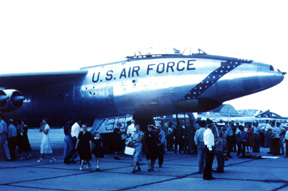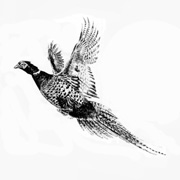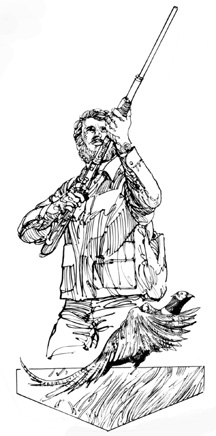|
Relating to The Earl E. Myers Story Chapter 24 — RB-47 Combat Crew Operations Page 2 of 2 |
||||||||
| As mentioned earlier in Chapter 2, in 1957, a building at the old Grand Island Army Air Corp Base was to be dedicated and Nebraska. Sen. John Hruska requested a B-47 for static display from SAC Hdqs. My Sq. C.O. asked if I was interested in making the flight as it was on a weekend. “Sure” was my reply and off we went. My co-pilot at the time was Lt. George Nunes and the Nav was Lt. Les Lescovich, both retired as Bird Cols. I had called my brother who was 10 years younger than me to let him know of my arrival.
We departed Forbes with 35,000 lbs of fuel and a load of water-alki., 168 miles to G.I. On arrival we made a slow pass, gear-flaps down at about 500' feet and another high speed at 450 knots, pulled up and reduced power and entered the traffic pattern for landing. On departure we had so many people around the aircraft that we couldn't start engines. We had to ask for police to move them back. On takeoff as we departed, I hit the water injection with only about 20,000 lbs of fuel. Takeoff roll was about 2,200 feet and the climbout was very nose high. We did a 270 degree turn and came back across at 450Ks (about 570 mph) indicated and headed back to Forbes and landed about 20 min. later. |
||||||||
 |
||||||||
|
L to R, Captain Earl Myers, Lt. George Nunes, and Lt. Les Lescovich Below: There was no shortage |
||||||||
 |
||||||||
|
RB-47E making water-injection takeoff from Grand Island Airport |
||||||||
 |
||||||||
| Life moved on at Forbes and in January 1959 I was appointed Squadron Commander of the 320th Recon Squadron which gave us yet another excuse for a celebration, many of which were quite memorable. We had a multitude of name celebrities that performed at the Officers Club. These included Artie Shaw, the Smothers Brothers and many others. One weekend we had Hilo Hattie when our Squadron sponsored a Hawaiian blowout, complete with fresh pineapples. We cut off the heads of the pineapples and hollowed out the center, then filled them with crushed ice and rum. The refills were excellent also. Just add ice and more rum. The food was typical of Hawaii and it was ample for seconds and more if you cared to. Hilo Hattie performed for our wing and a good time was had by all.
Another party was a "Toilet" party. One of our pilots, Jackie Joiner was the inventor of that one. Col Ariel Neilson was our Division Commander then. He was very reserved, as was his wife. When he entered the club, my being the Sq. Commander and the ranking host officer present, it was my duty to meet he and his wife. I escorted them to the "punch bowl". Jackie had obtained a "new" toilet and we had the punch mixed up in the tank and then flushed it into the bowl below, using toilet paper for napkins. They did not hesitate to consume the drink that had plastic worms in this concoction. There was nothing said as to this "PUNCH BOWL" by either one of them that evening. The party progressed and a name entertainer performed, although I can't recall his name. Monday morning I received a request to report to the Division Commander. It was not a very friendly interview with our Commander, but at the end there was a P.S. with a positive note. “When's the next party?” Man I was home free. We had a club officer that was really hip to entertainment. He would carve an ice sculpture for a banquet at the drop of a hat. It was really a treat to see his work of art as he made an attractive sculpture out of a 200 lb block of ice. He used a hammer, an ice pick and a chisel to accomplish his task |
||||||||
 |
||||||||
|
In Oct. of 1960, four of us boarded a Forbes AFB Aero Club Beechcraft bound for Grand Island, Nebraska for pheasant hunting. The group included myself, my son, Steve, Pappy Reeves and Johnie Brashears.
[Note: Johnie later lost his life while departing from Kindley Field Bermuda. The refulers had filled his RB-47’s water injection tanks with 600 gallons worth of a 50 50 water/fuel mix (ADI) that was designed for use “only” in reciprocating engines not jet engines. As the water injection system was activated, about half way down the runway on the takeoff roll, all six (6) engine temperature gauges (EGTs) went off the redline scale as the engines overheated. All six (6) engines failed as the B-47s airspeed passed through 150 knots. The aircraft crashed into the bay and hit some coralstone hills on the far side of the bay. There were no survivors.] We took off at about 0500 a.m. for the 1 hour and 30 minute flight to Grand Island. (For the RB-47, from Forbes, it would be a 16 minute flight.) The flight was uneventful and we saw a beautiful sun up. My brother Harold was there to meet us. We were soon off, by car, to hunt northwest of Grand Island We arrived about 1 hour later at the farm belonging to a friend of Harold’s. The farm included several hundred acres of corn, milo and hay for the cattle, etc. We had prior permission to hunt the area. While we were getting organized for the hunt, a small, single engine, high wing aircraft, a Piper J-3 Cub, buzzed us and then landed. The owner of the airplane had a paper route and also delivered mail to remote areas. As I observed the owner/pilot of the aircraft, I noted that he was doing some funny things. I asked my Dad if the pilot had been drinking. His reply was “Yes, the pilot had a drink just before takeoff”. I found out later that, on occasion, my Dad and this pilot would go coyote hunting from this small plane. I mentioned to my Dad not ever to fly with this pilot/farmer again. That same day, without my Dad being a passenger, this pilot took off, making several unusual maneuvers much too close to the ground. He stalled out and went into a spin and crashed. It is impossible to recover from a spin at 200'. There was no rush to go to the aircraft as it hit so hard that we all could feel the impact from where we stood. On arrival at the crash site about 5 minutes later, we found the fuselage crushed forward to the engine with the very dead pilot squished in between. Later investigation revealed that drinking and flying was a normal routine with this individual. There was no log book or maintenance records for the aircraft. It is conceivable that no maintenance had been performed other than to change spark plugs like might have been the case for his Ford 8N tractor where he put in gas and oil and just ran it as long as things seemed to be working OK. That is no way to maintain and fly and airplane. Our hunting was over for the day and the day had just started. |
||||||||
| After taking care of loose ends, we began our hunt the next day and all had our limits by noon. The 3rd day, our hunting was finished about 1700 hrs and by the time we arrived at the airport it was already dark. After loading our Beechcraft, we took off and cruised through the darkness. Soon, Marysville, Kansas was observed on the horizon. About that time the engine started to overheat and there was no doubt that a landing was necessary in the very near future. Marysville had an airport, but there were no runway lights and the airport closed at sundown. |
 |
|||||||
| According to the aeronautical chart the airport was just at the city limits to the Northeast. We struggled to remain airborne heading Northeast of the city. We judged the distance to locate the airport from the edge of the lights from the city .
It was darker than Central Africa. The engine was very tired and it was a sure thing that we were going to come in contact with the ground very soon. We were losing altitude with no reduction in power. We landed, and thanks be to God, we were on the airport property — although not on the runway. Fortunately the ground was smooth, although I can’t say the same for the landing. We left the airplane where it stopped and had to walk about 1/4 mile to the airport office where we found a phone and called a cab. We stopped at the VFW and had a libation or "TWO". A call home to Topeka was made and we waited about 2.5 hours before someone showed up to bring us home. I made a resolution, on the spot, after landing — There would be no more night flying in a civilian single engine aircraft. It was over a month before the aircraft was returned to Topeka with a new engine installed. Our Father, thanks for allowing us to land and not crash. |
||||||||
 |
||||||||
| In due time I was transferred to wing Operations to work in the Command Post with Col. Ariel Neilson, who had just been promoted to B/Gen at the same time I had been promoted to Major. As we were conversing, almost every time I answered his question I would forget and address him as Col. His response was, OK Capt...... That stopped that situation on the spot. He was a fine officer. Now deceased.
In April, 1960, the 90th SRW was disbanded and the 40th Bomb Wing moved from Smoky Hill AFB to Forbes. At that time, I was reassigned to the 40th BW. While serving with the 40th Bomb Wing, I was sent TDY to Eilsen AFB, Alaska as Operation's Officer under Col. Robert Worrell, Alert Force Commander. He was TDY from Malstrom AFB and was a great guy to be associated with. The tour of duty was 16 weeks. During that period, there would be occasions for a functional flight check after a major component was replaced. I often volunteered to do the test flight as it was a period for me to relax and be away from the "KLAXON" (The “Alert” horn.). My doing this also served to relieve the crews who were off duty so they could enjoy more time off by not being required to do a test flight. There would be times when an aircraft needed to be defueled or refueled. It was usually easier for me to move it to the fuel pit, rather than finding a flight crew or using a tug. It also kept my proficiency up. On one occasion a test flight was required and, at the completion of the test hop, a normal traffic pattern was flown. On approach a "MOOSE" was sighted about 200 yards to the left of the runway eating grass. The approach was continued and just at flare out, the "MOOSE" was seen running like mad toward the runway (he was trying to get on the other side, like why did the chicken cross the road?.). The commitment to land had already been made. The J-47 engines on a B-47 are very slow to spool up. Power was advanced rather rapidly and as we neared the MOOSE's position, take off speed was violated by about minus 10 knots. Off we came just as we passed the BULL "MOOSE", the front landing gear truck hit him and broke his back. It jolted the aircraft substantially. As we flew around the traffic pattern,while waiting for a front end loader to move the "MOOSE," our fuel was becoming very near minimum emergency. The spooked "MOOSE" was moved clear of the runway, just in time for us to make a normal landing. The NCO and Officers Club enjoyed "MOOSE" roasts, steaks and "MOOSEBURGERS" for some time. The poor guy weighed over 2,000 lbs. I don't know what spooked him but believe me he was SPOOKED. Thus the Nickname of "MOOSE" was handed down to me. If you take a deep breath and then holler as loud as you can "MMMOOOOSSEE", that was the common start of a briefing or my entrance to the dining hall or O-Club. In the wider view, my assignment with the 40th Bomb Wing was not a happy or satisfying period in my Air Force career. The wing command staff didn't seem to know how or want to absorb a Reconnaissance staff member into their Bombardment operational management clique. My duties involved that of Alert Force Operations Officer, Alert Facility Supervisor, test hops that others did not want to do, and a variety of related activities. One of the memorable events that raised some hackles on both sides involved my coming to the rescue of a S/Msgt who had a heart attack on the ramp, in the middle of a winter blizzard, simultaneously when the quick reaction Alert Force had been told to start engines and prepare to launch. Seeing this man laying on the ground, amidst the hubbub, I immediately called for the ambulance (there was a stand-by ambulance at the alert facility), began giving him CPR and continued to do so when he had been loaded into the ambulance and enroute to the hospital. For reasons I never could understand, my Director of Operations was offended by my choice of priorities in performing my various responsibilities. He believed I was abandoning my primary duties during the alert by attending to the needs of the heart attact victim. He went so far as to bring charges against me for leaving the Alert Facility area during an alert exercise. Upon investigation, the charges were dropped. Some time later, I was assigned to take 15 B-47s TDY to Moron AB, Spain for a special project and return. While there, during a break in the action, I went over to Torrejon AB to 16th AF Headquarters and asked to see General Ryan. That's when he came out of his office and shook my hand and said, “I believe you would like to be transferred to 16th AF for duty.” I agreed with him fully, and by the time I returned to Forbes the orders for the transfer were waiting for me. Although this action angered some of my immediate supervisors, I personally could not have been more pleased. I went home to pack up my family with great enthusiasm. Editor's Note: For those of you who would like to review some End of Page 2 of 2, Chapter 24 — Go to Chapter 25 Go to EEM Introduction —Chapter 1 — 2 — 3 — 4 — 5 — 6 — 7 — 8 |
||||||||